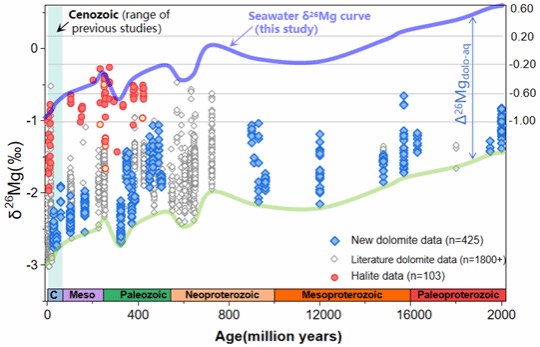Life has flourished on Earth for billions of years, and the biological habitability of its environment hinges crucially on the presence of liquid water. In the vast universe, planets exhibit a large range of temperatures, varying from thousands of degrees Celsius to -200 degrees Celsius. In contrast, the narrow temperature range of 0-100 degrees Celsius is essential for maintaining Earth's habitability. How Earth maintained habitable despite constant changes in solar radiation, mantle degassing intensity, and crustal compositions over billions of years remains a profound scientific challenge.
Greenhouse gases, particularly carbon dioxide (CO2), play a crucial role in regulating Earth's climate. Scientists have long recognized the magnesium cycle as a fundamental regulator of the carbon cycle. However, the evolution of Earth's Mg cycle throughout geologic history remains poorly quantified.
Recently, an international research team led by Professor Weiqiang Li from Nanjing University made a significant breakthrough by successfully reconstructing the history of seawater Mg isotope composition for the past 2 billion years. This represents a remarkable advancement, as previous studies on seawater Mg isotopes were limited to the Cenozoic era, spanning the past 65 million years. Using this new record, the research team reconstructed the history of surface Mg cycles over the last 2 billion years. The study reveals that dolomite, a common sedimentary Mg-rich carbonate mineral, exerts a significant climatic influence. As Earth's temperature rises or volcanic degassing intensifies, dolomite burial increases, removing additional CO2 from the atmosphere. This process mitigates the greenhouse effect and ensures that Earth's temperature does not reach catastrophic levels. Therefore, the dolomite cycle serves as a geo-thermostat that had been under-appreciated previously, offering a potential explanation for Earth's habitability.

Details of this study can be found in the paper published in Science Advances, entitled “The evolution of Earth’s surficial Mg cycle over the past 2 billion years.”
Link to the paper: https://www.science.org/doi/10.1126/sciadv.adj5474
Source: School of Earth Sciences and Engineering
Writer: Li Weiqiang
Correspondent: Wu Yiwen